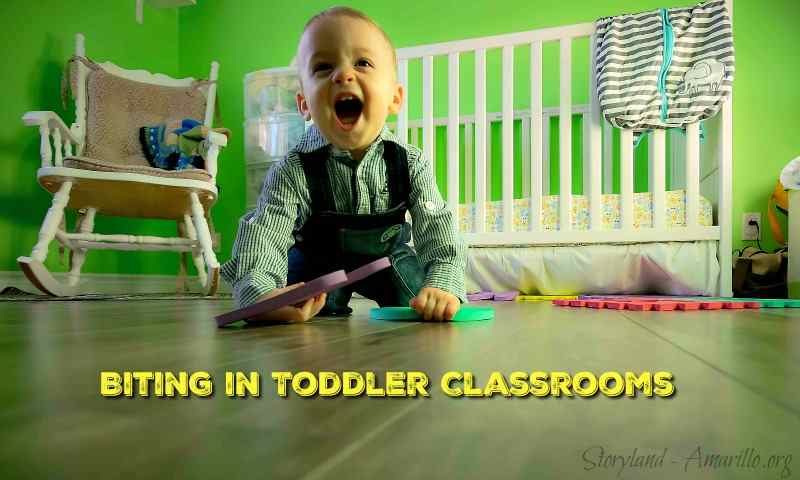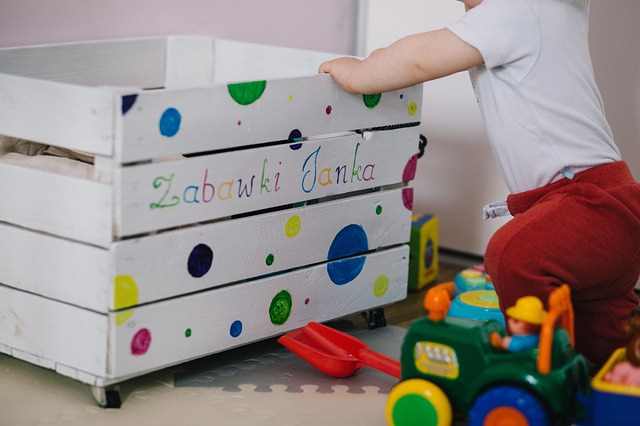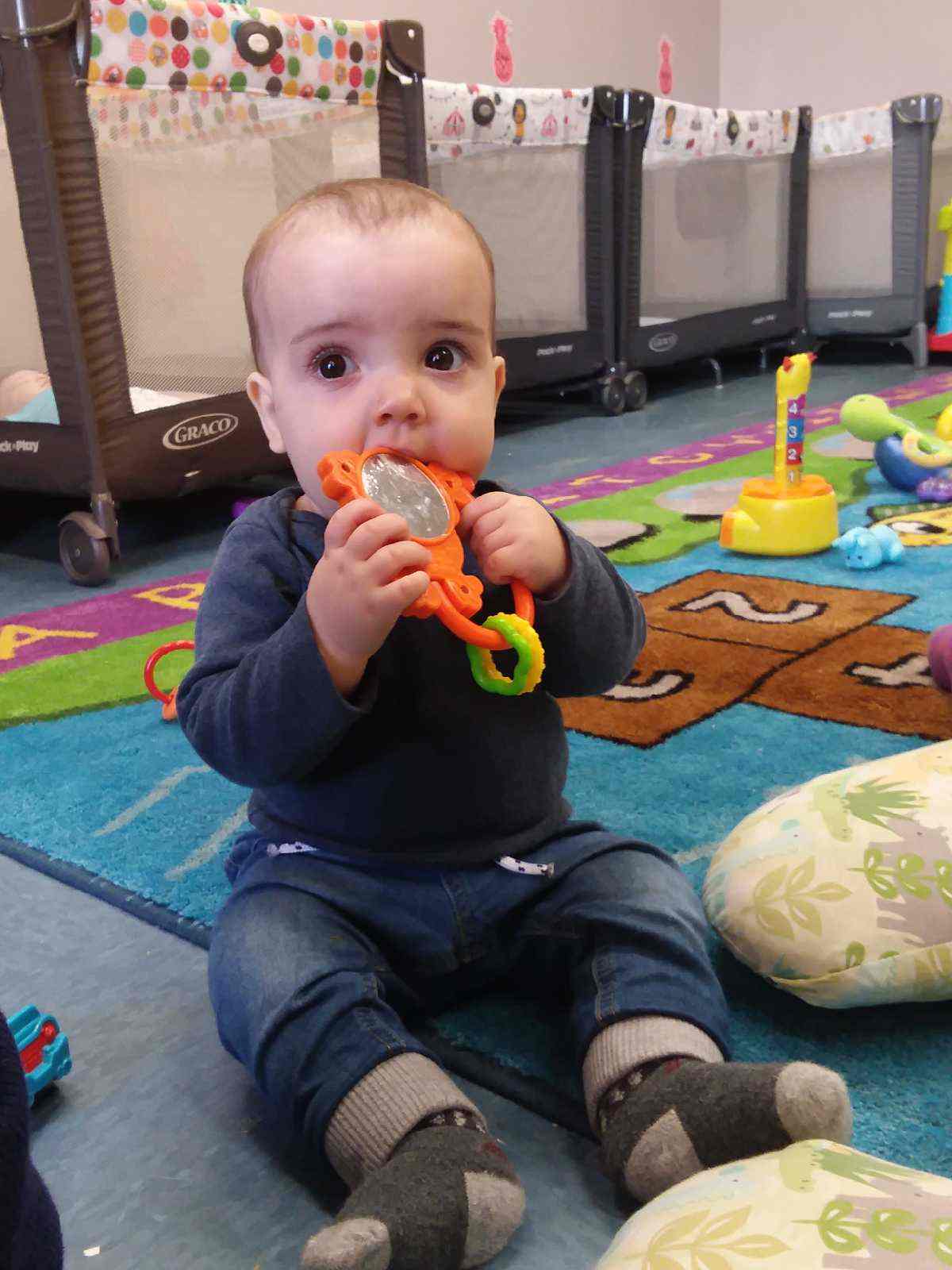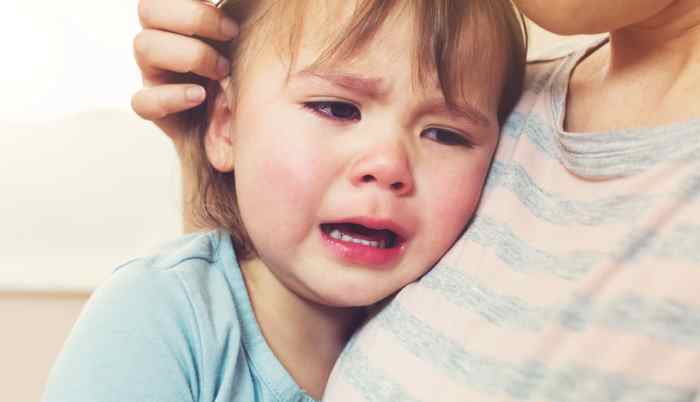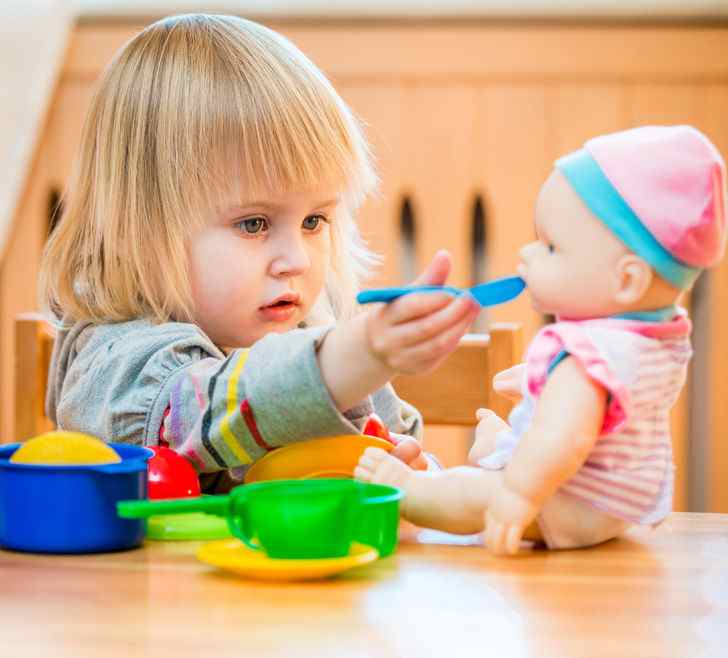Biting in Toddler Classrooms: What Can Be Done
Biting in Toddler Classrooms happens frequently, and it is often surprising and even shocking to new parents.
Biting is one of those behaviors that most people find repulsive and overly aggressive. Dogs bite, cats bite, hamsters bite, but surely not humans. Right?
The truth is that like animal babies, domestic and wild, human infants and toddlers bite. It is a natural response and one that has been studied for a very long time. Whether we like to admit it or not, it is an uncomfortable reality for children ages 13 to 30 months that some of them will bite and others will be bitten by other toddlers.
Parents of the Biter and the Bitten
For a parent who has a child bitten in daycare, the intensity of feelings run high. Anger indignation and frustration are often the most common feelings expressed by parents who receive bite reports at the end of a long workday. “How could they let my toddler be bitten – he’s too young to fight back or defend himself!”
For the parent of the biter, intense emotions also emerge – frustration, confusion helplessness, even self-blame. “How can this happen, he never bites at home!”
Some parents even go so far to imagine a toddler who bites as turning into an adult mass murder. Or how about the parent whose toddler has been bitten. Will he turn out to be bullied all his life? Will he never stand up for himself? Before we go farther, please erase these thoughts entirely from your head as neither have any validity.
Parents have every right to own their feelings of anger and frustration, however, how we eventually deal with these emotions will determine how well the outcome will be for their children.
Parents blame other parents. Parents blame the teachers or the childcare facility. There is no end to the blame that often results when biting takes place.
Before we get into the causes, I want to emphasize that playing a blame game is not constructive. It may make the parent of a child that has been bitten feel better initially, but it does not solve the problem.
The fact that a toddler bites is not the fault of the parent or the toddler. As we will see below, toddler biting is a developmental issue caused by toddlers having strong emotions and feelings coupled with their inability to manage them. Think of biting like the common cold. You can do everything you can to protect or prevent your child from getting sick, but germs are everywhere. It happens. It’s not fun for the parent or the child, but no one would consider the parent of a sick child “bad.”
How Prevalent is Biting in Toddler Classrooms?
According to the American Psychological Society,
“Between a third and a half of all toddlers in daycare are bitten by another child, studies indicate; in fact, epidemiological studies peg that number at closer to half of all children in daycare.”
Just do a Google Search, and you will find about 1,700,000 hits for the search terms “Biting in Childcare Centers.”
While it may be comforting to know that your child is not the only child ever bitten in a child care facility, it is no less anger-provoking when it happens.
Consider this scenario:
A new parent writes, “My two-year-old has been going to the same daycare since she was 6 weeks old. Overall, we have been pleased until recently. She has begun getting bitten by another child in her class. (recorded 1997)
My 17-month-old daughter has been bitten twice by the same girl at her daycare. This last one was on her face. My daughter doesn’t know how to defend herself or fight back, and I depend on the teachers to protect her, but that obviously is not happening.” (recorded 2001).
I added the dates of occurrences because I want to make the point that this is not a new problem. Many toddlers that were bitten in child care are now parents of their own.
Since child care has become a universal institution providing care so mothers and fathers can work, biting has happened including the blaming and anger that occurs between parents, and between parents and caregivers.
Why do Toddlers bite?
From day one, an infant will gradually become more aware of his surroundings, the sights, sounds, smells and textures all around him. As he grows, his curiosity expands, and one of the first ways that a young infant will explore his world is with his mouth. We all know this. Babies put things in their mouths, begin to mouth, chew and then bite on objects.
The Beginnings of Biting: Infancy
Infants begin to experiment with biting when they bite their teething toys, pacifier, the shoulder of an adult, or their mother’s breast. Mothers will typically respond quickly, mostly involuntary to a surprise bite on their sensitive human skin. After a couple of these bites, infants begin to associate biting with pain. Many infants learn enough about biting to move onto the next lesson. One cannot label these bites as being good or bad, they are just what infants do as they learn.
Most parents would never consider punishing, lecturing, or blaming an infant for biting their delicate skin. They may, however, respond with a loud, “ouch, please don’t bite.” Like so much that children must learn, there may be many painful bites before the lessons are learned.
Biting in Toddlerhood
Toddlerhood presents more independence and the opportunity to make choices. With this new-found freedom comes the ability to make independent decisions. Where will he walk, what toy will he choose, who will he play with. Unfortunately, these behaviors are emerging before the toddler can verbalize or describe any feelings that he is experiencing. At this stage, these new feelings can be overwhelming at times.
The emotions of an adult can be very complicated. Just look at a chart of emoticons describing some of our complicated feelings.
Toddlers are at the initial stage of recognizing and identifying their feelings. They will eventually come to understand their emotions over time by the loving guidance of parents and teachers. But, at this point, they have strong feelings but not the vocabulary, knowledge or ability to describe or manage them. This is why you see major meltdowns in the form of tantrums. These intense emotions are just too overwhelming for a young toddler.
(May I also interject that strong emotion may be complicated for some adults as well)
Inability to Manage Strong Emotions Bring on Biting
We all know what it feels like to be stressed. Infants and toddlers are not immune from this stress. Consider the many ways adults deal with stress – some more appropriate than others. Toddlers are likely to cry, throw tantrums, and even bite. Biting in toddler classrooms is often the result of strong emotions.
Toddlers need outlets and ways to express their stress, frustrations, fears or anger just like anyone else. This needs to happen daily to maintain mental health whether it is in toddlers, parents or anyone else for that matter.
Fear takes many forms. Toddlers don’t fully understand why their parents aren’t showering them with attention. They’re confused by moms and dads’ need to work, shop, cook, take care of other things and don’t have as much time as the toddler seems to demand. Some toddlers may either be fearful or anxious in a classroom setting where they must share the attention of teachers with a classroom full of other children.
Stress is thrown at us from all angles and is especially acute for young children. A change in a child’s schedule or routine, a relocation, the birth of a new sibling, new people living in the home, people moving out of the house, discord within the home, witnessing violence, illness, the list goes on.
Stress, either acute or chronic is harmful to a person even when that person can identify what is happening. Toddlers are incapable of understanding this complex issue that causes such tension.
Anger is a powerful emotion and often a scary one to a young toddler. A toddler who was playing with a toy may find himself experiencing a strong overwhelming angry feeling when a classmate grabs the toy from him. This is a common occurrence in childcare settings, but not the only reason for biting as many suspects.
Frustration often requires some form of an outlet. When a toddler’s frustrations build up until he feels like he might explode, he may cry, throw a tantrum, or bite the child standing next to him. Frustration is often observed in a toddler or two-year-old classroom.
To provide a consistent environment, teachers will give a relatively structured situation that requires a flexible schedule with calming routines. All children respond to frustrations differently depending on their temperament.
Some children may get frustrated when they are told that it is time to come in from outside play or stop a favorite activity because it is lunchtime. Remember that toddlers have not practiced enough socially acceptable ways of dealing with their frustration. Again, this is a developmental issue that will resolve over time as the toddler exercises better methods to relieve his tension.
Biting in Toddler Classrooms, Example One:
One child observes another child playing and having fun with a toy.
The second child wants to have the same experience and grabs the toy.
The first child is startled and enraged. He bites.
Biting in Toddler Classrooms, Example Two:
Two children are playing near each other.
The teacher tells the children it is time to put toys away.
One child takes his toy and the toy of the second child and tries to put it away.
The second child bites the other.
How Can Parents Deal With the Child Care Facility
Becoming angry with the daycare teachers will not help the situation and will likely make it worse. Teachers don’t want to see a child being hurt, and it can become even more frustrating when there are multiple biters in a room. Plenty is going on in a toddler classroom. Parents who think the teacher is not doing her job when a bite occurs, consider this typical 45-second scene in a toddler room.
- Child number one is trying to climb on a chair and needs immediate guidance to help keep him safely on the floor.
- Child number two is in the process of having a diaper change.
- Child number three has pulled his pants down and trying to use a potty.
- Child number four is playing with blocks on the floor.
- Child number five is sitting next to Child number four and holding a doll.
- Child number six is sitting next to child number five and trying to force a play baby bottle into the doll being held by child number six.
- Child number seven is looking for something to do and accidentally trips and falls onto child number four.
- Child number four turns around and bites child number 7.
Got the idea? Now multiply those 45 seconds by a typical 10-hour day for the average toddler.
How Young Children Play Impacts Biting in Toddler Classrooms
Unlike classrooms for five-year-old and above, toddler classrooms have children who are a rudimentary level of play. This means that for the most part, everyone plays by themselves or is playing nearby another child.
Some children have advanced to a more sophisticated play and may try simple cooperative play as is the case with child five and six.
Toddlers are also clumsy, have a very short attention span, and are always on the go. Don’t get me wrong, I love toddlers, but as charming and loving as they are, I think of them as novice people with many lessons to master.
Preventing and Discouraging Future Biting in Toddler Classrooms
Here are some simple ways to discourage biting in toddlers.
At Child Care Centers such as Storyland, there are many ways that teachers prevent biting every day.
- Predictable schedules and routines provide stability and comfort to children. When toddlers know what to expect, stress levels vastly decline.
- Close supervision is crucial in a child care setting, not only by the teachers in the room but by how the environment is organized. Go into any classroom at Storyland and observe. There aren’t what we call blind spots where teachers might not see all children.
- Low staff-child ratios. Most classes have two teachers with allows one to spend more time observing children who may be potential biters.
- A wide variety of toys to choose. When there is a particularly favorite toy, you’ll likely see more of them. This reduces the frustrations of learning to share. (A skill that will come later with experience.)
- Teachers need to show a great deal of patience. Teachers don’t like biting. They don’t want to see children hurt. They know, however, that biting at this level is almost inevitable.
- Consistent techniques. Good practices dictate that teachers will respond in predictable ways that the children can expect. There are no surprises that may cause stress or anxiety on the part of the children.
- Prevent bites from happening in the first place by keeping children busy and engaged in activities.
- Know that biting often occurs when the teacher is unable to get to the biting situation such as when she is diapering another child.
- When biting does occur, a consistent process occurs. The child that was bitten is comforted and first aid provided as needed. The biter is told in a very firm voice that biting is never OK. Biting is not allowed and biting hurts. The teacher’s words may be different, but the message is the same. “NO BITING!” There is usually a cooling off time, and then the biter is redirected to more appropriate behavior. This is not done in a harsh way but rather in a loving, gentle manner. It often takes many repetitions for a child to understand that biting in toddler classrooms is not allowed.
These methods work with most children most of the time. It is, however, little comfort to parents when teachers prevent 15 bites from happening each day, but one bite does occur, and it happens to be their child.
Suggestions for Parents: First, What Doesn’t Work to Stop Biting in Toddler Classrooms
- First and foremost, complaining, threatening, or announcing to the world that their child has been bitten yet another day due to the teacher’s incompetence is not a solution. Teachers work very hard for very little pay (most work for what would not be considered a “livable wage.” They work because they love children, enjoy being around them for extending periods of time, and hope to make a difference of the next generation.
- Get angry and go to licensing. Parents have every right to submit a formal grievance to licensing, but parents who do this fail to understand the process involved. Parents who do this are more inclined to want to right a perceived wrong, and a licensing report will not do this.
In the rare event that licensing does find that one of the 1000s of regulations have been violated, there will be a “violation report” and a citation listed on the site for a period. In most cases, licensing will submit a report that states, “no violations found.” This only hurts if not destroys the teacher-parent relationship. Preschool teachers work hard at not only establishing a warm, positive relationship with the child but also a powerful partnership with the parent that can often last for years.
Suggestions for Parents: What Does work to Reduce or Eliminate Biting in Toddler Classrooms
- Parent-teacher conference: Arrange for a time that is convenient for the teacher to discuss the problem. Pick up and drop off times are usually not the best time to schedule a conference. Be honest and express your frustrations. Ask the teacher for advice and listen to her recommendations. Remember that we are talking about complex human behaviors that teachers have some experience. They are, however, not doctors or clinical psychologists.
- Parent – Director Conference: Sometimes sitting down with the director and/or assistant director may be very helpful. She may be able to offer some insight after observing the classroom and make recommendations.
- Like other behaviors, biting is one of the hardest to manage in a child care setting, but nearly ubiquitous. Understand that teachers are doing everything they can to prevent and deal with biting. Biting does not last forever. Understand that we experience few if any biting instances in our 3, 4, or 5-year-old classrooms. If biting is a problem by the time a child reaches 3 years old, it is dealt with as we would deal with any other inappropriate behaviors.
- Sometimes, a parent decides to make a change, and every parent is free to do so. For some children, being individually cared for in their home by a nanny is the best solution. Sometimes an ideal solution would be to find an in-home provider that cares for a couple of children might be another alternative. Still, others seek out informal arrangements with grandparents or other relatives. There are various choices when it comes to childcare and pros and cons of each one. Sometimes the hardest decision a parent has to make is to choose the type of care that is right for their child. There are many advantages to placing a child in a center environment, but there are also drawbacks. Each child is different.
Biting in Toddler Classrooms: The Takeaway
Parents have a right to be upset when their children are bitten, but they should also try to understand how the teachers and the parents of the biters feel about the situation. Parents are sometimes embarrassed that their children do bite.
Since there is no way that the average household could ever duplicate or mimic what goes on in a typical classroom, most biters typically don’t bite at home.
Children don't bite because they have bad parents. Children don’t get bitten because they have bad parents.
Children bite because they're trying to express emotions that they cannot yet put into words.
We can work diligently to prevent and discourage biting, but our techniques won’t work for all children.
Playing the blame game or vindictive retaliation methods don’t work and may set up a precedent for future child issues that may cause more harm than good.
